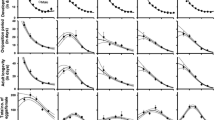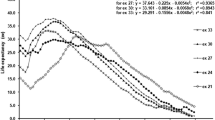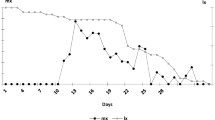Abstract
Aceria mississippiensis andCoptophylla caroliniani (Prostigmata: Eriophyidiae) were found on wild geranium,Geranium carolinianum L., in northern Mississippi. About onehalf of the total developmental time was spent in the egg stage for each species. The developmental threshold forA. mississippiensis was 5.5±1.04°C and 7.3±0.93°C forC. caroliniani. The optimum temperature for each developmental stage was between 25 and 29°C.C. caroliniani failed to develop at 36°C, whereasA. mississippiensis failed at 40°C. Day-degree requirements to complete development were 100.7±3.6 Do and 154.6±4.1 Do forC. caroliniani andA. mississippiensis, respectively.
Mean female longevity at 20°C was 17.4 (range 12–21) days forC. caroliniani and 16.5 (range 15–19) days forA. mississippiensis. The shortest pre-oviposition period was 2.2 days forC. caroliniani at 20°C and 1.7 days forA. mississippiensis at 25°C, and the length of pre-oviposition period increased with temperature above 25°C for both species.
Maximum egg production ofC. caroliniani andA. mississippiensis occurred at 20°C. There were no differences (P≤0.05) in number of eggs per day at temperatures of 20, 25 and 32°C for each species, but there was a tendency to lay more eggs per day with increasing temperature. The percentages of egg hatch were not significantly different at these temperatures. The sex ratio of laboratory-rearedA. mississippiensis was 1:1.8, whereas field-collectedC. caroliniani showed a ratio of 1:1.
Similar content being viewed by others
References
Abou-Awad, B.A., 1979. The biology and morphology ofEriophyes datura Soliman and Abou-Awad (Acari: Eriophyoidea: Eriophyidae). Acarologia, 21: 392–395.
Bailey, S.F. and Keifer, H.H., 1943. The tomato russet mite,Phyllocoptes destructur Keifer: its present status. J. Econ. Entomol., 36: 706–712.
Baker, G.T., 1985. Morphology of the solenidia and famulus on tarsi I and II ofRhizoglyphus robini Claparede (Acaridae). Zool. Jb. Anat., 113: 85–89.
Baker, G.T., Stadelbacher, E. and Chandrapatya, A., 1986. Changes induced in the structure ofGeranium carolianum byCoptophylla caroliniani andAceria mississippiensis (Prostigmata, Eriophyidae). Z. Angew. Entomol. (in press).
Baker, J.R. and Neunzig, H.H., 1970. Biology of the blueberry bud mite. J. Econ. Entomol., 63: 74–79.
Caresche, L.A. and Wapshere, A.J., 1974. Biology and host specificity of theChondrilla gall miteAceria chondrillae (G. Can.) (Acarina, Eriophyidae). Bull. Entomol. Res., 64: 183–192.
Chandrapatya, A. and Baker, G.T., 1986. Two new species of eriophyid mites (Prostigmata: Eriophyidae) on wild geranium (Geranium carolinianum L.) in Mississippi. Can. J. Zool., 64: 400–406.
Das, G.M. and Sengupta, N., 1958. Observations on the pink miteAcaphylla theae (Watt) Keifer, of tea in North-west India. J. Zool. Soc. India, 10: 39–48.
Das, G.M. and Sengupta, N., 1963. Biology and control of the purple mite,Calacarus carinatus (Green), a pest of tea in North-east India. J. Zool. Soc. India, 14: 64–72.
Domes, R., 1957. Zur Biologie der GallmilbeEriophyes gracilis Nalepa. Z. Angew. Entomol., 41: 411–424.
Easterbrook, M.A., 1978. The life history and bionomics ofEpitrimerus piri (Acarina: Eriophyidae) on pear. Ann. Appl. Biol., 88: 13–22.
Easterbrook, M.A., 1979. The life-history of the eriophyid miteAculus schlechtendali on apple in South-east England. Ann. Appl. Biol., 91: 287–296.
Farkas, H.K., 1963. On the Eriophyids of Hungary IV. The Description of New Species (Acari: Eriophyidae). Acta Zool. Acad. Sci. Hung., 9: 237–270.
Fisher, R.A., 1958. The Genetical Theory of Natural Selection. Dover Publications, New York, 291 pp.
Hamilton, W.D., 1967. Extraordinary sex ratios. Science, 156: 477–488.
Hatzinikolis, E., 1971. A contribution to the study ofAceria oleae (Nalepa. 1900) (Acarina: Eriophyidae). In: Proc. 3rd Int. Congr. Acarology, Prague, 1971, pp. 221–224.
Keifer, H.H., 1952. The eriophyid mites of California (Acarina, Eriophyidae). Bull. Calif. Insect Surv., 2: 1–123.
Kido, H. and Stafford, E.M., 1955. The biology of the grape bud miteEriophyes vitis (Pgst). Hilgardia, 24: 119–142.
King, C.B.R., 1937. Notes on the life history ofEriophyes carinatus Green. Bull. Entomol. Res., 28: 311–314.
Krantz, G.W., 1973. Observations on the morphology and behavior of the filbert rust mite,Aculus comatus (Prostigmata: Eriophyoidea) in Oregon. Ann. Entomol. Soc. Am., 66: 709–717.
Liro, J.I., 1940: Neue Eriophyiden aus Finnland. Ann. Zool. Soc. Zool. Bot. Fenn., Vanamo, 8: 1–68.
Merwe, G.G. van der and Coates, T.J., 1965. Biological study of the grey miteCalacarus citrifolii K. S. Afr. J. Agric. Sci., 8: 817–824.
Oldfield, G.N., 1969. The biology and morphology ofEriophyes emarginatae, aPrunus finger gall mite, and notes onE. prunidemissae. Ann. Entomol. Soc. Am., 62: 269–277.
Oldfield, G.N., Hobza, R.F. and Wilson, N.S., 1970. Discovery and characterization of spermatophores in the Eriophyoidea (Acari). Ann. Entomol. Soc. Am., 63: 520–526.
Putman, W.L., 1939. The plum nursery mite (Phyllocoptes fockeui Nal. and Trt.) Ont. Entomol. Soc. 70th Annu. Rep., pp. 33–40.
Rice, R.E. and Strong, F.E., 1962. Bionomics of the tomato russet mite,Vasates lycopersici (Massee). Ann. Entomol. Soc. Am., 55: 431–435.
Roivainen, H., 1950. Eriophyid news from Sweden. Acta Entomol. Fenn., 7: 1–51.
Roivainen, H., 1951. Contributions to the knowledge of the Eriophyids of Finland. Acta Entomol. Fenn., 8: 1–70.
Rosario, M.S. del and Sill, W.H., 1964. Additional biological characteristics ofAceria tulipae (Acarina: Eriophyidae). J. Econ. Entomol., 57: 893–896.
Stadelbacher, E.A., 1981. Role of early-season wild and naturalized host plants in the buildup of the F1 generation ofHeliothis zea andH. virescens in the Delta of Mississippi. Environ. Entomol., 10: 766–770.
Sternlicht, M., 1967. A method of rearing the citrus bud miteAceria sheldoni (Ewing). Isr. J. Agric. Res., 17: 57–59.
Sternlicht, M., 1970. Contribution to the biology of citrus bud mite,Aceria sheldoni (Ewing) (Acarina: Eriophyidae). Ann. Appl. Biol., 65: 221–230.
Sternlicht, M. and Goldenberg, S., 1971. Fertilization, sex ratio and post embryonic stages of the citrus bud miteAceria sheldoni (Ewing) (Acarina, Eriophyidae). Bull. Entomol. Res., 60: 391–397.
Sternlicht, M., Goldenberg, S. and Cohen, M., 1973. Development of the plum gall and trials to control its miteAcalitus phloeocoptes (Eriophyidae, Acarina). Ann. Zool. Ecol. Anim., 5: 365–377.
Swirski, E. and Amitai, S. 1959. Contribution to the biology of citrus rust mite (Phyllocoptruta oleivorus Ashm.). C. Oviposition and longevity of males and females. Ktavim, 9: 281–285.
Taylor, P.D. and Bulmer, M.G., 1980. Local mate competition and the sex ratio. J. Theor. Biol., 86: 409–419.
Werren, J.H., 1980. Sex ratio adaptations to local mate competition in a parasitic wasp. Science, 208: 1157–1159.
Author information
Authors and Affiliations
Rights and permissions
About this article
Cite this article
Chandrapatya, A., Baker, G.T. Biological aspects of the geranium mites,Coptophylla caroliniani andAceria mississippiensis (Prostigmata: Eriophyidae). Exp Appl Acarol 2, 201–216 (1986). https://doi.org/10.1007/BF01193952
Accepted:
Issue Date:
DOI: https://doi.org/10.1007/BF01193952




